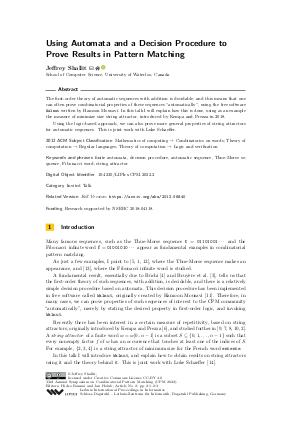Using Automata and a Decision Procedure to Prove Results in Pattern Matching (Invited Talk)
Author
Jeffrey Shallit 
-
Part of:
Volume:
33rd Annual Symposium on Combinatorial Pattern Matching (CPM 2022)
Part of: Series: Leibniz International Proceedings in Informatics (LIPIcs)
Part of: Conference: Annual Symposium on Combinatorial Pattern Matching (CPM) - License:
 Creative Commons Attribution 4.0 International license
Creative Commons Attribution 4.0 International license
- Publication Date: 2022-06-22
File

PDF
LIPIcs.CPM.2022.2.pdf
- Filesize: 0.52 MB
- 3 pages
Document Identifiers
Related Versions
- Full Version https://arxiv.org/abs/2012.06840
Subject Classification
ACM Subject Classification
- Mathematics of computing → Combinatorics on words
- Theory of computation → Regular languages
- Theory of computation → Logic and verification
Keywords
- finite automata
- decision procedure
- automatic sequence
- Thue-Morse sequence
- Fibonacci word
- string attractor
Metrics
- Access Statistics
-
Total Accesses (updated on a weekly basis)
0Document
0Metadata
Abstract
The first-order theory of automatic sequences with addition is decidable, and this means that one can often prove combinatorial properties of these sequences "automatically", using the free software Walnut written by Hamoon Mousavi. In this talk I will explain how this is done, using as an example the measure of minimize size string attractor, introduced by Kempa and Prezza in 2018. Using the logic-based approach, we can also prove more general properties of string attractors for automatic sequences. This is joint work with Luke Schaeffer.
Cite As Get BibTex
Jeffrey Shallit. Using Automata and a Decision Procedure to Prove Results in Pattern Matching (Invited Talk). In 33rd Annual Symposium on Combinatorial Pattern Matching (CPM 2022). Leibniz International Proceedings in Informatics (LIPIcs), Volume 223, pp. 2:1-2:3, Schloss Dagstuhl – Leibniz-Zentrum für Informatik (2022)
https://doi.org/10.4230/LIPIcs.CPM.2022.2
BibTex
@InProceedings{shallit:LIPIcs.CPM.2022.2,
author = {Shallit, Jeffrey},
title = {{Using Automata and a Decision Procedure to Prove Results in Pattern Matching}},
booktitle = {33rd Annual Symposium on Combinatorial Pattern Matching (CPM 2022)},
pages = {2:1--2:3},
series = {Leibniz International Proceedings in Informatics (LIPIcs)},
ISBN = {978-3-95977-234-1},
ISSN = {1868-8969},
year = {2022},
volume = {223},
editor = {Bannai, Hideo and Holub, Jan},
publisher = {Schloss Dagstuhl -- Leibniz-Zentrum f{\"u}r Informatik},
address = {Dagstuhl, Germany},
URL = {https://drops.dagstuhl.de/entities/document/10.4230/LIPIcs.CPM.2022.2},
URN = {urn:nbn:de:0030-drops-161297},
doi = {10.4230/LIPIcs.CPM.2022.2},
annote = {Keywords: finite automata, decision procedure, automatic sequence, Thue-Morse sequence, Fibonacci word, string attractor}
}
Author Details
Funding
Research supported by NSERC 2018-04118.
References
-
A. Amir, Y. Aumann, A. Levy, and Y. Roshko. Quasi-distinct parsing and optimal compression methods. In G. Kucherov and E. Ukkonen, editors, CPM 2009, volume 5577 of Lecture Notes in Computer Science, pages 12-25. Springer-Verlag, 2009.

-
H. Bannai, M. Funakoshi, T. I, D. Köppl, T. Mieno, and T. Nishimoto. A separation of γ and b via Thue–Morse words. In T. Lecroq and H. Touzet, editors, SPIRE 2021, volume 12944 of Lecture Notes in Computer Science, pages 168-178. Springer-Verlag, 2021.

-
V. Bruyère, G. Hansel, C. Michaux, and R. Villemaire. Logic and p-recognizable sets of integers. Bull. Belgian Math. Soc., 1:191-238, 1994. Corrigendum, Bull. Belg. Math. Soc. 1:577, 1994.

-
J. R. Büchi. Weak secord-order arithmetic and finite automata. Z. Math. Logik Grundlagen Math., 6:66-92, 1960. Reprinted in S. Mac Lane and D. Siefkes, eds., The Collected Works of J. Richard Büchi, Springer-Verlag, 1990, pp. 398-424.

-
M. Karpinski, W. Rytter, and A. Shinohara. An efficient pattern-matching algorithm for strings with short descriptions. Nordic J. Computing, 4:172-186, 1997.

-
D. Kempa and N. Prezza. At the roots of dictionary compression: string attractors. In STOC'18 Proceedings, pages 827-840. ACM Press, 2018.

-
T. Kociumaka, G. Navarro, and N. Prezza. Towards a definitive measure of repetitiveness. In Y. Kohayakawa and F. K. Miyazawa, editors, LATIN 2020, volume 12118 of Lecture Notes in Computer Science, pages 207-219. Springer-Verlag, 2020.

-
K. Kutsukake, T. Matsumoto, Y. Nakashima, S. Inenaga, H. Bannai, and M. Takeda. On repetitiveness measures of Thue-Morse words. In C. Boucher and S. V. Thankachan, editors, SPIRE 2020, volume 12303 of Lecture Notes in Computer Science, pages 213-220. Springer-Verlag, 2020.

- S. Mantaci, A. Restivo, G. Romana, G. Rosone, and M. Sciortino. String attractors and combinatorics on words. In ICTCS 2019, volume 2504 of CEUR Workshop Proceedings, pages 57-71, 2019. Available at URL: http://ceur-ws.org/Vol-2504/paper8.pdf.
-
S. Mantaci, A. Restivo, G. Romana, G. Rosone, and M. Sciortino. A combinatorial view on string attractors. Theoret. Comput. Sci., 850:236-248, 2021.

- H. Mousavi. Automatic theorem proving in Walnut. Arxiv preprint arXiv:1603.06017 [cs.FL], 2016. URL: http://arxiv.org/abs/1603.06017.
-
J. Radoszewski and W. Rytter. On the structure of compacted subword graphs of Thue-Morse words and their applications. J. Discrete Algorithms, 11:15-24, 2012.

-
W. Rytter. The structure of subword graphs and suffix trees of Fibonacci words. Theoret. Comput. Sci., 363:211-223, 2006.

- L. Schaeffer and J. Shallit. String attractors for automatic sequences. Arxiv preprint arXiv:2012.06840 [cs.FL], 2021. URL: http://arxiv.org/abs/2012.06840.
-
J. Shallit. The Logical Approach To Automatic Sequences: Exploring Combinatorics on Words with Walnut. Cambridge University Press, 2022. In press.

